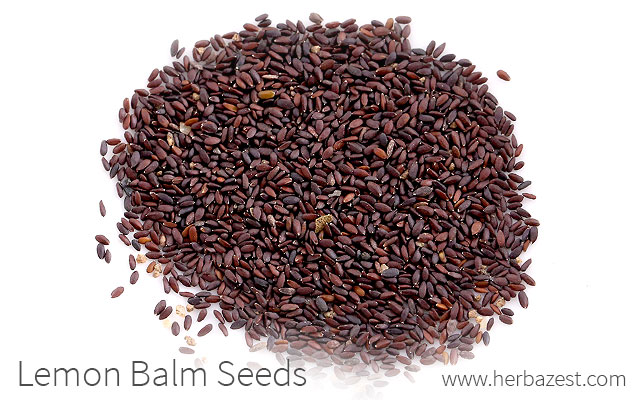Lemon balm differs from other mint species in the way it propagates. While the latter spread by underground runners, lemon balm self-spreads by seeds. However, it also can be propagated by cuttings, and there are infertile varieties like citronella, which will deliver an intense lemony fragrance without producing any seeds.
Characteristics of Lemon Balm Seeds
After lemon balm blooms, the flowers will dry out, but the stalks will keep the seeds. However, they won't be ready to be collected until they get dark brown. The seeds of lemon balm are as inconspicuous as its flowers.
IT TAKES APPROXIMATELY 2,000 LEMON BALM SEEDS TO MAKE A SINGLE GRAM
How to Collect and Store Lemon Balm Seeds
The delicate task of extracting lemon balm seeds can only be done by hand:
- Carefully separate the dried stalks from the stem.
- Roll the dried flower or stalk over your open palm using your fingers. The dried material will get crushed, leaving a few tiny seeds.
- To avoid the rolling process and possible loss of seeds, the stalks also can be placed upside down in a paper bag so that the seeds will drop when they are ready.
- After collecting the seeds, they can be stored inside of a paper bag in a dry, dark spot until the sowing season comes, usually early spring.
- Since home-collected seeds are organic and not previously treated, they can be preserved for no more than a year to ensure they will germinate.
Sowing Lemon Balm Seeds
Lemon balm plant is easy to grow from seed sown in the spring or early autumn. Direct outdoor seeding is a not uncommon among gardeners, since it is a way to regulate their home production. However, it requires efficient weed control, and the use of garden beds or containers is highly recommended.
Sowing Indoors
- Sow indoors in spring, six to eight weeks before the last frost
- Cover slightly with sifted soil or seed-starting formula
- Keep the soil moist at 70oF (21oC)
- Lemon balm seeds are very sensitive to damping-off, so it is better to allow them to germinate uncovered. Seedlings will emerge in 14 - 21 days
Sowing Outdoors
- Sow in average soil in full spring sun, after the danger of frost has passed
- Remove weeds and work organic matter into the top six to eight inches (15 - 20 cm) of soil; then level and smooth
- Sow seeds evenly and cover lightly with fine soil
- Firm the soil lightly and keep evenly moist
- Seedlings will emerge in 14 - 21 days
How to Obtain Lemon Balm Seeds
There two different ways to obtain the seeds of lemon balm: getting them from a fellow gardener, who collected them from his own lemon balm plants, or buying them. When buying seeds, you'll have to choose among three kinds: non-organic (which have been chemically treated), organic (without chemical treatment), and Certified Organic (free of pesticides and other chemical treatments, from certified producers). However, prices and shelf life will vary slightly. Seeds can be easily found at retail stores (e.g., Walmart, Costco), garden supply stores (e.g., Home Depot, William-Sonoma), and online retailers (e.g., Burpee, Amazon).
Before sowing lemon balm seeds, beginners should be aware that lemon balm is an extremely invasive species. To control self-propagation, it is recommendable to cut off some flowers before they die and leave only the stalks that will be collected later for seeds. Some gardeners recommend cutting back lemon balm plants after they flower in order to allow new leaves to grow with more intense aroma and flavor.
Sources
- Government of South Africa, Department of Agriculture, Forestry and Fisheries Essential Oil Crops. Production guidelines for lemon balm
- Herb Society of America, Lemon Balm: An Herb Society of America Guide




